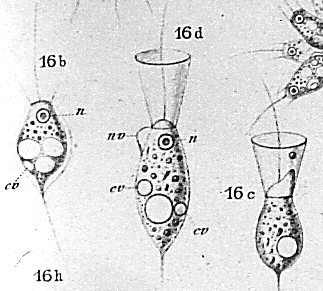Introduction to the Choanoflagellata
Where it all began for the animals


Composed of only about 150 species, the Choanoflagellata are not a diverse group of protists. They are small single-celled protists, found in both fresh waters and the oceans, taking their name ("collar-flagellates") from the circle of closely packed microvilli, or slender fingerlike projections, that surrounds the single flagellum by which choanoflagellates both move and take in food. The microvilli are so closely packed that under light microscopy, the collar appears as a single transparent unit, as it does in these drawings. As the flagellum beats, it draws water through the microvilli in the collar, which filter out bacteria and other tiny food particles. The flagellum may push the cell forward, in the case of free-swimming choanoflagellates; many species, however, are attached to a substrate by a thin stalk for part or all of their life cycles. They reproduce by simple division, and sex is unknown, yet their life cycles are not yet thoroughly studied.
Choanoflagellates have no fossil record, although some marine species secrete delicate loricae, or outer coverings, made of fine, interwoven silica bars. Though delicate, such loricae could conceivably be preserved as fossils. Yet choanoflagellates must have existed on the Earth since the Late Precambrian, because they are the closest living protist relatives of the sponges, the most primitive metazoans. Choanoflagellates are almost identical in shape and function with the choanocytes, or collar cells, of sponges; these cells generate a current that draws water and food particles through the body of a sponge, and they filter out food particles with their microvilli. Choanoflagellate-like cells are also found in other animal phyla; in organisms such as flatworms and rotifers, for instance, choanoflagellate-like cells are found in flame bulbs that act as excretory organs. A few living choanoflagellates, such as Proterospongia, are colonial for part of their life cycle, and show a limited degree of cell differentiation and integration into a unit; these colonial choanoflagellates are the best living examples of what the ancestor of all metazoans may have looked like.
For additional information:
On-line information about
Salpingoeca,
a typical solitary choanoflagellate, may be found at the
Protist
Image Database at the Univerity of Montreal.


